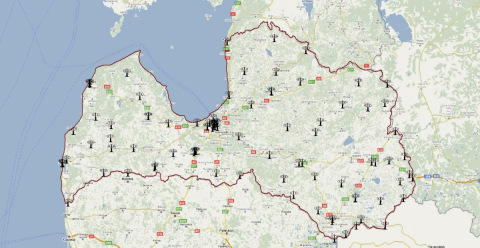
What are private mobile communications?
PMR is a professional mobile radio communication system (mobile radio communication system for a closed group of users - private electronic communication networks).

Private mobile communications are mobile communications between base stations and terrestrial mobile / portable stations or between terrestrial mobile / portable radio stations.

Traditional PMR users are taxi, security, railway, electricity supply and various cargo handling companies. Radios have been known as a safe and reliable form of radio communication for many years, and during these years capabilities of radios have changed and improved, and many additional functions have appeared.
Mobile communication equipment can be classified according to signal transmission technology:
- Analogue broadcasts:
- FM; AM; PM
- Digital transmissions:
- TETRA (DQPSK); TETRA II TEDS (QAM);
- APCO Project 25 (C4FM-4FSK); Project 25 Phase II (HDQPSK);
- Tetrapol;
- DMR (4FSK-TDMA);
- dPMR (FSK narrow band); NXDN (4FSK)
Operating modes of PMR communication system
PMR communication systems can be divided into:
- simplex - transmission takes place in only one direction at a time

- duplex- transmission takes place simultaneously in both directions

*F1 - Transmitting frequency of the base station
*F2 - Transmitting frequency of the portable radio
Radio frequency spectrum for PMR communication systems
In accordance with the Regulations of the Cabinet of Ministers of 6 October 2009 “Regulations on the Allocation of Radio Frequency Spectrum Bands to Types of Radio Communications and Classification into Radio Communication Systems, as well as on General Conditions for the Use of Radio Frequency Spectrum Bands (hereinafter National Radio Frequency Plan)”, the following frequency bands are allocated for PMR radio systems:
- 30-80 MHz;
- 146-174 MHz;
- 389-390 MHz/399-399,9 MHz;
- 406,1-410 MHz;
- 410-430 MHz;
- 440-450 MHz;
- 457,5875-460 MHz/467,5875-470 MHz
Narrowband PMR systems operate in frequency band 146-174 MHz, using 12.5 kHz and 25 kHz radio channel increments, and they can be divided according to the operating modes into:
- simplex - transmission takes place in only one direction at a time
- In duplex mode, the distance between the base and mobile part frequencies is determined as 4.6 MHz. In order to make the use of frequencies efficient and to make it easier to plan frequency allocations for both simplex and duplex operation mode, the 146-174 MHz band is divided into several subbands, where specific frequency bands are defined for each type of radio communication system operation.

/4,6 Mhz duplex separation/
Simplex and duplex frequency bands:
SI - frequency bands intended for operation in simplex mode;
DU - frequency bands intended for duplex operation;
FB1 / 2/3/4 - frequency bands in which base stations transmit;
ML1 / 2/3/4 - frequency bands for mobile stations.
In 146-174 MHz band, more than 800 licenses for the use of the terrestrial mobile service radio network and 1349 valid radio frequency allocations have been issued. Locations of the base stations are shown on the map.

Figure: Base station locations in 146-174 MHz band
The 146-174 MHz band is mainly used for voice and security signaling radio network operations, but it is also used for other applications. The advantage of using this band is that, compared to the UHF band (300-3000 MHz), due to the propagation characteristics of radio waves, it is possible to provide greater radio network coverage. To increase the coverage of a radio network, a repeater is often installed, that is, on the roof or tower of a tall building, a stationary station and an antenna are installed that receive signals from a mobile / portable station and transmit the received signal to other mobile or portable radio stations. Since the repeater is placed higher than mobile or portable radio stations, the distance at which mobile / portable radio stations can communicate with each other using repeaters is greater and communication is more stable.

Figure: Repeater usage scheme
The largest users of frequencies in this frequency band are Latvenergo, whose voice radio communication base stations are located throughout Latvia, as it is necessary to provide communications at transmission line infrastructure sites and Latvijas dzelzceļš, and companies related to railway transportation, infrastructure maintenance, which use frequencies on railway routes throughout Latvia.
Security companies also use this band to ensure operation of security alarm radio communication networks, as well as small radio communication networks with a small number of radios, which require radio communication on limited (company) territories.
Frequency band 406.1-410 MHz is intended for operation in simplex communication mode, mostly radio communication networks are active where only portable and mobile radio stations are used for voice communication.

Figure: Base station locations in 406.1-410 MHz band
Frequency band 410-430 MHz is intended for operation in narrowband mobile communications in duplex communication mode with duplex separation of 10 MHz, with large group radio communication networks operating in this band, according to the number of radios.

Figure: Base station locations in the 410-430 MHz band
Frequency band 440-450 MHz is intended for operation in narrowband mobile communications and fixed radio systems in simplex mode.

Figure: Base station locations in 440-450 MHz band
This frequency band is mainly used for data transmission networks, telemetry and telecontrol communications. In total, more than 250 radio network licenses have been issued.
Frequency bands 457.5875-458.1125 MHz and 467.5875-468.1125 MHz are intended only for provision of railway communications, which are also actively used. In total, more than 140 radio network licenses have been issued.

Figure: Base station locations in 457.5-460 MHz / 467.5-47 MHz band













